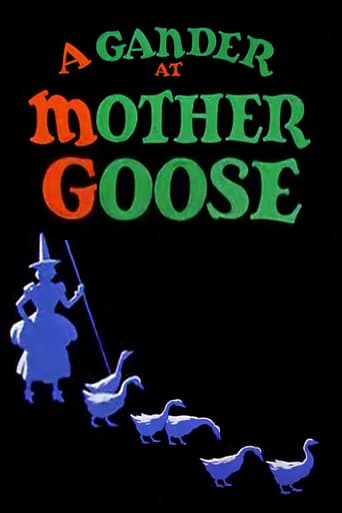Edgar Allan Pooh
. . . or an Anti-Broads Tirade. Among the notable rears exposed during A GANDER AT MOTHER GOOSE are Humpty Dumpty's bare buns (mooning viewers after his "great fall"), Jack-Be-Nimble's flaming posterior, and America's Guardian Bald Eagle, who pulls Hiawatha's arrow from his bottom. On the other hand, Mistress Mary displays an ugly attitude toward agriculture, Snottily Proclaiming that gardening "stinks;" Jill seems to be a total tart, leaving Jack covered with hickeys on the hill; Miss Muffet has enough facial deformities to scare her spider away; and the morbidly obese but not-so-old Lady Living in a Shoe seems to be the not-so-bright sex slave of a particularly lazy yet very fertile skinny bald guy. It's all enough to give the Big Bad Wolf bad breath. This early example of on-screen, mid-story Product Placement (for Listerine) leaves one wondering how much GANDER GOOSE producer Leon Schlesinger may have pocketed here in the form of Payola.
slymusic
"A Gander at Mother Goose", directed by Tex Avery, is a wonderful Warner Bros. cartoon that essentially has no plot. Instead, it presents a series of clever comic spin-offs of classic children's fairy tales. You wouldn't expect anything less from the wacky Warner Bros. cartoon studio! My favorite moments from "A Gander at Mother Goose": I love Carl Stalling's jazzy music score during the opening credits, as well as Humpty Dumpty's butt joke, as well as the dog's reaction to receiving a tree after wishing on a star, as well as the Big Bad Wolf slobbering the words "huff" & "puff" and overreacting to the pigs' insistence that he use mouthwash.One final point regarding the Jack & Jill sequence in this cartoon. It reminds me of the lyrics to a song: "Jack and Jill went up a hill, / Jill came down with a twenty-dollar bill!"
Lee Eisenberg
Fairy tales were often used as the basis for cartoons in the days of yore. Warner Bros. cartoons usually twisted them into jokes, with Friz Freleng's "Three Little Bops" ("Three Little Pigs" as a jazz song) as the crowning achievement. An earlier effort was Tex Avery's "A Gander at Mother Goose". This was one of many cartoons from the era using children's stories and nursery rhymes as excuses for spot gags. This was not the best one. I personally think that Tex worked best when focusing on an elaborate plot - as was the case with "The Isle of Pingo Pongo" and "Thugs with Dirty Mugs" - so that he could create neater gags.Still, this one isn't bad. Aside from getting to see more of Humpty Dumpty than we expect (they actually got it past the censors!), we can probably guess what Jack and Jill are really doing! Of course, about two months later, Tex brought to the silver screen "A Wild Hare", introducing Bugs Bunny in his first true form. So this one works mostly as a place holder. OK, not great.
ccthemovieman-1
This cartoon features a lot of the cornball stuff Warner Brothers and others liked to use in the 1930s and the first year or two of the '40s: poking a little fun at famous fairy tales and imitating actress Katharine Hepburn with her affected "Bryn Mawr accent" to play a role or two.Humpty Dumpty, Jack and Jill, Little Miss Muffet, The Three Little Pigs, the Little Old Lady Who Lived In A Show, and more are all depicted with one-joke scenes. Unfortunately, the jokes all fell flat with either the joke coming from dialog or a sight gag.I wonder if audiences actually laughed at the theater in 1940 over this stuff. I doubt they would today; it's just a little too dated, humor-wise, to be rated more than a "4," and that's being generous. It's just not funny and certainly not the Tex Avery stuff we animated fans came to love later in the decade.



